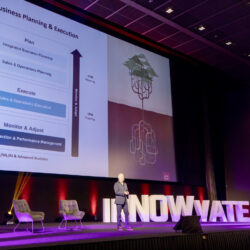‘S&OP implementation can and must be much faster’

Many companies continue to struggle with sales & operations planning (S&OP) and integrated business planning (IBP). Eric van Dijk, CEO of Slimstock, advocates a practical approach. “You don’t learn how to play football by studying the theory. You have to kick a ball around on a pitch. Just have a go, and learn from your mistakes,” he stated during a recent webinar organized by Supply Chain Media. To shorten the learning curve, Slimstock is launching a new initiative: the S&OP Competence Centre.
By Marcel te Lindert
Van Dijk criticized the slow implementation of S&OP and said that it’s simply no longer acceptable for projects to take two years or more: “S&OP has become much too big. It can and must be done faster, especially if you want the key stakeholders to get involved, such as the people responsible for sales, product development and finance. As soon as they realize that it will take two years before the process produces any results, they lose interest. After two or three sessions they start sending their assistants instead, and the momentum vanishes.”
Gap in the business plan
In Slimstock’s view, S&OP actually revolves around four issues. The first concerns the realization of the business plan drawn up by the board. “Supply Chain knows how much of it has already been achieved and what the forecast is for the rest of the year. The discussion should be about the gap between the goal formulated by the board and the results that Supply Chain foresees. If you can quantify that gap and translate it into revenue and margin per region or product group, you can then start discussing that with the stakeholders.”
The second issue relates to long-term trends such as sustainability. As an example, Van Dijk mentioned the shift from traditional lightbulbs to LED lighting in electrotechnical wholesale, and the rapid growth in meat replacements in the foodservice market. “What will be the revenue share of these new products in three years’ time? How will that impact on the supply chain? Can my suppliers keep up with that? Perhaps there aren’t any companies that can supply those new products yet.”
Anticipating disruptions
The third issue relates to incidents with a long-term impact on the supply chain, such as when the Ever Given blocked the Suez Canal. “The question is, how big will the supply chain impact be? If the problems only last for two or three months you might be able to cope with the inconvenience. But if it will last longer, then you need to be able to anticipate that. Many companies are struggling with a computer chip shortage at the moment, but there are also some companies who aren’t affected. That’s a matter of planning.”
The fourth issue concerns supply chain limitations. Van Dijk: “In fact, that comes down to how you react to the first three issues. You might have an opportunity to source enough chips for the coming year, but do you have enough capital to do so? Or what if you don’t need chips but huge products instead, and your warehouse is too small? If you take a big enough step back, you can spot those kinds of limitations coming way in advance and anticipate them – such as by renting extra warehousing space.”
Negative message
Slimstock sees companies struggling with these issues. Supply chain managers are often quick to realize it when the business plan targets are unattainable, but how can they initiate the right discussion about this? “It doesn’t help that the message is usually negative. Someone from Supply Chain is coming to tell you that something’s not going according to plan again. And if that results in a discussion, the level of detail is often too low; it’s about one specific item that is performing above or below expectations, or it’s an observation that the sales targets aren’t being met. The question is, how can you use data to create insights and trigger a good discussion?” explained Jan Kraaijeveld, Business Development Manager at Slimstock.
There is often a lot of data available in the supply chain, but it fails to get effectively translated into insights for senior executives. “Take the shift from traditional lighting to LED lighting. Show the board what is happening: that wholesalers are reducing their stock of traditional lighting and building their stock of LEDs, and that the new products have a short life cycle which creates extra inventory management risks. That helps to keep the board focused,” added Van Dijk.
S&OP Competence Centre
To help create the right insights for senior executives, Slimstock has built an S&OP/IBP layer on top of its Slim4 inventory optimization system. “The data required for this is actually already in Slim4. This layer can be implemented in just ten days, giving companies the foundation for S&OP,” continued Van Dijk. “So it’s not an extra IT project. The focus is on the processes and the people who have to work with them. By making the data accessible very quickly we enable people to start using it, which is the only way they’ll learn.”
To promote learning about S&OP, Slimstock has taken the initiative to establish an S&OP Competence Centre aimed at bringing companies together so that they can exchange knowledge and experience. “We want to do the same as we did before with the Inventory Management Competence Centre (IMCC): bring people together so they can openly share their knowledge and experience. We’re all in the same field of work and have similar goals. By working together, we can make tremendous progress.”










